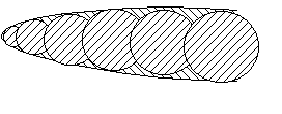| |
|
Puff Models: Application
| Puff models are simple models that look at the movement of air (including pollutants) as "puffs" of air moving in three dimensions (x,y, and z) over some period of time (t). |

|
The graphic shows a rough schematic of a puff model: a small box of air begins at some location in three-dimensional space and time, and then, depending on air flow, moves to some new location over some change in time.
 |
A typical puff model will look to visualize how a particular chemical species (or collection of species) will change over a period of time.
|
The graphic shows a single plume coming from a stack, and how the puff grows in size over a period of two timesteps, simulating dilution of the original concentration of pollutants coming out of the plume.
| In puff models, we can simulate the plume by constructing a series of overlapping and/or intersecting puffs. The graphic at right shows how a plume is simulated using this technique. |

|
 |
Puff models may have advantages in situations where there are significant breaks in terrain, such as hilly areas or areas with many buildings, or when winds are stagnant or variable. Plume models assume that downwind transport is sufficient to model pollutant dispersion, and along-wind dispersion is generally neglected. This graphic shows how puff models can more accurately model dispersion crosswind. Notice that both plume and puff models produce the same results for some distance (typically 10-20 km), but that outside of this radius they produce different results.
|
The major difference between plume models and puff models is that puff models look at quasi-instantaneous or short-term releases, while plume models are more continuous in nature.
|
|